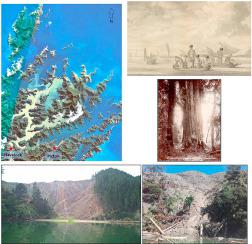当前位置:
X-MOL 学术
›
Ocean Coast Manage.
›
论文详情
Our official English website, www.x-mol.net, welcomes your
feedback! (Note: you will need to create a separate account there.)
From ‘clean and green’ to ‘brown and down’: A synthesis of historical changes to biodiversity and marine ecosystems in the Marlborough Sounds, New Zealand
Ocean & Coastal Management ( IF 4.8 ) Pub Date : 2020-12-01 , DOI: 10.1016/j.ocecoaman.2020.105349 Stephen C. Urlich , Sean J. Handley
Ocean & Coastal Management ( IF 4.8 ) Pub Date : 2020-12-01 , DOI: 10.1016/j.ocecoaman.2020.105349 Stephen C. Urlich , Sean J. Handley

|
Abstract Ecosystem-based management (EBM) is a potential antidote to the alleviation of multiple stressors in highly-valued and contested marine environments. An understanding of the magnitude and drivers of past ecosystem changes can inform the development of realistic ecological and social outcomes for different places. These goals should aim to increase the ecological health and resilience of coastal ecosystems and their connected land- and sea-scapes by minimising anthropogenic disturbances. To address knowledge gaps, we present a marine historical synthesis of the Marlborough Sounds in New Zealand's South Island. These rias are strongly coupled to the surrounding land and inland river catchments. We took an integrated approach by examining effects of land use change on coastal ecosystems, along with case studies of the effects of exploitation on foundational marine species. We found that ecosystems have gone through a series of transformations since Māori settlement ca. 700 years ago, with localised extirpations of marine megafauna, overharvesting of exploited species, and disruption to ecological functioning through ongoing clearfelling of terrestrial and marine biogenic communities since European settlement in the 1800s. There has been a decline from great abundance of marine life to relative scarcity, which is currently evident to local people in increased effort and reduced allowable catches of fish and shellfish. Recovery of biodiversity in the short-term within the Marlborough Sounds is uncertain, given ongoing multiple and interacting stressors from unsustainable land-use and over-exploitation of marine life. Lifting baselines are possible but will require significant changes to land and marine management to restore ecological health and enhance resilience in the face of climate change. Increased marine protection, regeneration of biodiverse biogenic habitats, spatial fishing measures to increase predators of sea urchins, stricter regulation of plantation forestry and a replanting prohibition in critical erosion source areas, are all needed within an EBM framework. Large experimental areas are proposed to develop, test and integrate different management techniques, and to facilitate community understanding, participation, and support for the transition to EBM.
中文翻译:

从“清洁和绿色”到“棕色和向下”:新西兰马尔堡峡湾生物多样性和海洋生态系统的历史变化综合
摘要 基于生态系统的管理 (EBM) 是缓解高价值和有争议的海洋环境中多种压力源的潜在解毒剂。了解过去生态系统变化的幅度和驱动因素可以为不同地方的现实生态和社会成果的发展提供信息。这些目标应旨在通过最大限度地减少人为干扰来提高沿海生态系统及其相连的陆地和海洋景观的生态健康和复原力。为了解决知识差距,我们呈现了新西兰南岛马尔堡峡湾的海洋历史综合。这些河口与周围的土地和内陆河流域紧密相连。我们通过检查土地利用变化对沿海生态系统的影响采取综合方法,以及开发对基础海洋物种影响的案例研究。我们发现自毛利人定居以来,生态系统经历了一系列转变。700 年前,自 1800 年代欧洲定居以来,由于陆地和海洋生物群落的持续砍伐,海洋巨型动物的局部灭绝、已开发物种的过度捕捞以及生态功能受到破坏。海洋生物从丰富的数量减少到相对稀缺的程度,目前当地人民正在增加努力并减少鱼类和贝类的允许捕获量,这是显而易见的。鉴于不可持续的土地利用和海洋生物的过度开发带来的多重和相互作用的压力源,马尔堡峡湾内的生物多样性在短期内的恢复是不确定的。提高基线是可能的,但需要对陆地和海洋管理进行重大改变,以恢复生态健康并增强应对气候变化的复原力。加强海洋保护、再生生物多样性生物栖息地、增加捕食海胆的空间捕捞措施、对人工林进行更严格的监管以及在关键侵蚀源区禁止重新种植,都是 EBM 框架内需要的。拟开发、测试和整合不同的管理技术,并促进社区理解、参与和支持向 EBM 过渡的大型试验区。生物多样性生物栖息地的再生、增加海胆捕食者的空间捕捞措施、对人工林进行更严格的监管以及在关键侵蚀源区禁止重新种植,都是 EBM 框架内需要的。拟开发、测试和整合不同的管理技术,并促进社区理解、参与和支持向 EBM 过渡的大型试验区。生物多样性生物栖息地的再生、增加海胆捕食者的空间捕捞措施、更严格的人工林监管以及在关键侵蚀源区禁止重新种植,都是 EBM 框架内的必要条件。拟开发、测试和整合不同的管理技术,并促进社区理解、参与和支持向 EBM 过渡的大型试验区。
更新日期:2020-12-01
中文翻译:

从“清洁和绿色”到“棕色和向下”:新西兰马尔堡峡湾生物多样性和海洋生态系统的历史变化综合
摘要 基于生态系统的管理 (EBM) 是缓解高价值和有争议的海洋环境中多种压力源的潜在解毒剂。了解过去生态系统变化的幅度和驱动因素可以为不同地方的现实生态和社会成果的发展提供信息。这些目标应旨在通过最大限度地减少人为干扰来提高沿海生态系统及其相连的陆地和海洋景观的生态健康和复原力。为了解决知识差距,我们呈现了新西兰南岛马尔堡峡湾的海洋历史综合。这些河口与周围的土地和内陆河流域紧密相连。我们通过检查土地利用变化对沿海生态系统的影响采取综合方法,以及开发对基础海洋物种影响的案例研究。我们发现自毛利人定居以来,生态系统经历了一系列转变。700 年前,自 1800 年代欧洲定居以来,由于陆地和海洋生物群落的持续砍伐,海洋巨型动物的局部灭绝、已开发物种的过度捕捞以及生态功能受到破坏。海洋生物从丰富的数量减少到相对稀缺的程度,目前当地人民正在增加努力并减少鱼类和贝类的允许捕获量,这是显而易见的。鉴于不可持续的土地利用和海洋生物的过度开发带来的多重和相互作用的压力源,马尔堡峡湾内的生物多样性在短期内的恢复是不确定的。提高基线是可能的,但需要对陆地和海洋管理进行重大改变,以恢复生态健康并增强应对气候变化的复原力。加强海洋保护、再生生物多样性生物栖息地、增加捕食海胆的空间捕捞措施、对人工林进行更严格的监管以及在关键侵蚀源区禁止重新种植,都是 EBM 框架内需要的。拟开发、测试和整合不同的管理技术,并促进社区理解、参与和支持向 EBM 过渡的大型试验区。生物多样性生物栖息地的再生、增加海胆捕食者的空间捕捞措施、对人工林进行更严格的监管以及在关键侵蚀源区禁止重新种植,都是 EBM 框架内需要的。拟开发、测试和整合不同的管理技术,并促进社区理解、参与和支持向 EBM 过渡的大型试验区。生物多样性生物栖息地的再生、增加海胆捕食者的空间捕捞措施、更严格的人工林监管以及在关键侵蚀源区禁止重新种植,都是 EBM 框架内的必要条件。拟开发、测试和整合不同的管理技术,并促进社区理解、参与和支持向 EBM 过渡的大型试验区。











































 京公网安备 11010802027423号
京公网安备 11010802027423号